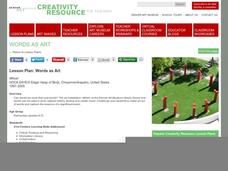Curated OER
Writing Genres and Rules
A fantastic presentation on writing is here for your students! This could serve a teacher's guideline on what to teach upper-elementary writers. An excellent resource for a teacher of language arts!
Curated OER
Standard English
Double negatives are a no-no in the English language, yet you hear people using them all the time. "I ain't got no pencils," is a classic example. This presentation addresses double negatives, and teaches learners how to avoid this...
Curated OER
Onomatopoeia
Some words actually sound like their meaning. When this happens, it's known as onomatopoeia. Learners look at a series of pictures, and match up a bunch of words with the pictures they sound like. For example, the word buzz would go with...
Novelinks
Tuck Everlasting: Similes, Metaphors, and Personification in Imagery
Poetic language is abundant in Natalie Babbitt's beautiful novel, Tuck Everlasting. Learners note the examples of similes, metaphors, and personification they find as they read, and illustrate how the language creates a sensory...
BBC
Recognizing Formal and Informal Language
When do you need to use formal language, and when is it cool to speak informally? Read these sentences and use a grid to help decide. This clever tool is followed by ten sample sentences to identify as formal or informal, perfect for...
K12 Reader
Animal Proverbs and Adages
What will play when the cat's away? Practice figurative language with a list of proverbs about animals. Kids use the word bank at the top of the page to fill in the blanks based on their knowledge of common phrases.
Super Teacher Worksheets
Idioms
If figurative language makes your kids feel blue or under the weather, use an activity focused on idioms to help them feel on top of the world. Kids complete a chart with seven idiomatic phrases, adding the meaning of each along with an...
Curated OER
Street Art Project
Illuminate your playground with chaulk images. Young aratists use the web to research the work of Keith Haring. Groups then design their own piece of visual art and recreate their images on the school sidewalks of blacktop.
Curated OER
Figurative Language
Review and discuss literary devices using this resource, a PowerPoint about personification, simile, and metaphor. Learners can talk about metaphors, similes, and personification. This could a part of a more in-depth discussion of these...
Curated OER
Ye Olde English Sayings
Discover the historical roots of modern English with your young learners, and then discover the meaning of many old English sayings. What a great chance to explore the history behind many of the words and phrases we use today!
LearnEnglishFeelGood.com
English Prefixes and Suffixes
Match prefixes and suffixes to their definition in a 10-problem grammar activity. Prefixes and suffixes in focus include muta-, pre-, aud-, post-, psych-, fid-, -ize, -dox, -urb, and anti-.
Smekens Education Solutions, Inc.
Introducing the 6 Traits to Students
Put together an English language arts unit on the six traits of writing with this helpful collection of resources. From fun songs to differentiated writing exercises reinforcing each of the traits, great ideas are provided for developing...
Houghton Mifflin Harcourt
Heroes: English Language Development Lessons (Theme 5)
This packet of support materials for the Houghton Mifflin Harcourt thematic units on heroes, contains lessons, exercises, and activities specifically designed for ELD/ESL learners.
Pearson
Catching the Sun: Tales from Asia
Explore the folklore of Asia and the South Pacific with this language arts lesson series. Complementing a reading of Catching the Sun: Tales from Asia by Jan M. Mike, this resource supports learners with understanding cause and effect...
K12 Reader
What Is a Simile?
As fun as a barrel of monkeys, this figurative language worksheet will engage your students in learning to write similes. Asking them to first think of adjectives describing the six nouns listed on the page, this exercise has young...
Curated OER
Camels Theme Unit
In this Camel themed worksheet, learners create an alliteration, an acrostic poem, and work with similes. The unit consist of three pages of language arts work, based on Camels.
Denver Art Museum
Words as Art
Elementary schoolers look at images of the art installation, Wheel -which is found at the Denver Art Museum. After a class discussion about how the words and symbols on the artwork make it more meaningful, the discussion turns toward how...
Curated OER
Vocabulary Building
A fabulous language arts lesson has readers focus on the vocabulary in the key words, expand and build new vocabulary, and practice three grammar concepts. They recognize key words as they relate to communicating at work. Pupils build...
Santa Clara County Office of Education
The Rainbow Fish: Activities for Parents to Do with Children at Home
The Rainbow Fish, Marcus Pfister's award-winning story about the joys of sharing, is the inspiration for this resource loaded with fun. Suggestions for language and language arts, math, science, and social studies activities are included...
Curated OER
It's Raining Cats and Dogs! Literary Devices and Figurative Language
Third and fourth graders study literary devices and figurative language. They view a PowerPoint presentation (which you must create) to review hyperbole, idiom, simile, and metaphor. They read and discuss the book There's A Frog in My...
Curated OER
Pop Art Personalities
Students study the artwork of Pop Artist Roy Lichtenstein, and compare and contrast his art with popular comic book imagery. They create drawings in Lichtenstein's style that reflect emotions in facial expressions and thought bubbles....
Forum
A Research Toolkit of 12 Reading Strategies for the Foreign Language Classroom
Learning to read is not a simple task, but there are methods for assisting pupils as they develop literacy skills. The first four pages of this resource include information about language development and reading development, as well as...
Hong Kong Special Administrative Region
Learning English through Poems and Songs
Exposing learners to the power of words in poetry is a stimulating way to learn languages. Songs, haikus, rhyming words, and narrative works are all employed in a resource for teaching English as a Second Language.
EngageNY
Writing Dialogue: Revising Historical Narrative Drafts to Add Dialogue
Young writers have written, revised, and peer-edited their historical fiction narratives by the 10th lesson plan in a language arts unit. Fourth graders finally combine their revision notes to create a second draft. The double-spaced...
Other popular searches
- English Language Arts
- English Language Arts Exam
- English Language Arts Games
- Deaf English Language Arts
- English Language Arts Music
- English Language Arts Heroes
- English Language Arts Skills
- English Language Arts Grade 3
- English/language Arts
- English Language Arts Poetry
- English Language Arts Rating=3
- English Language Arts Unit Sc

























